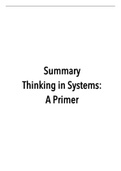Summary
Complete summary of the book: Thinking in Systems (Business Analysis for Responsible Organisation)
- Module
- Institution
- Book
Complete English summary of the book: Thinking in Systems: A Primer by Meadows written for the course 'Business Analysis for Responsible Organisation'/BAFRO. This summary includes Chapters 1-7 of the book.
[Show more]




